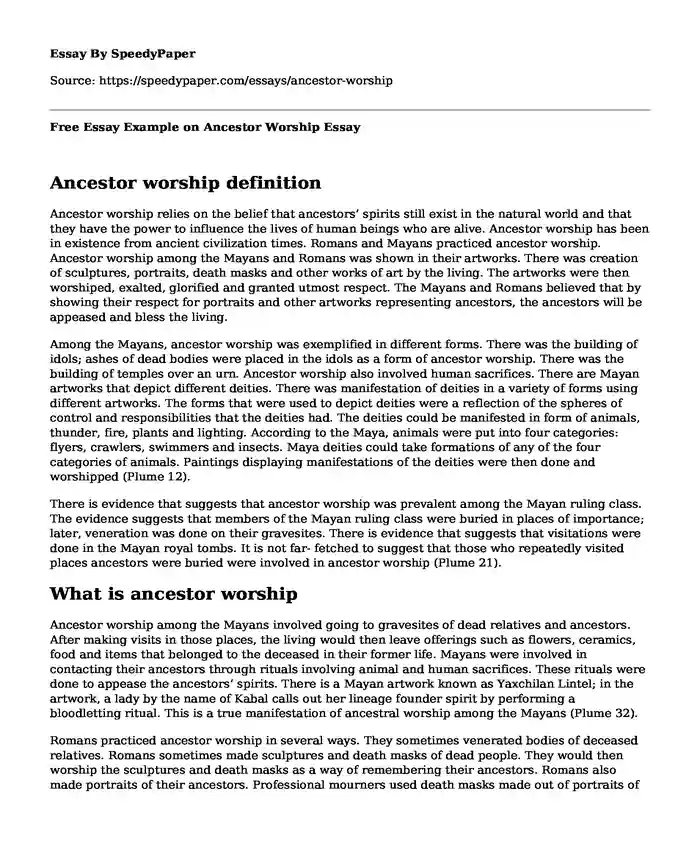
| Type of paper: | Essay |
| Categories: | History Anthropology Religion |
| Pages: | 3 |
| Wordcount: | 720 words |
Ancestor worship definition
Ancestor worship relies on the belief that ancestors’ spirits still exist in the natural world and that they have the power to influence the lives of human beings who are alive. Ancestor worship has been in existence from ancient civilization times. Romans and Mayans practiced ancestor worship. Ancestor worship among the Mayans and Romans was shown in their artworks. There was creation of sculptures, portraits, death masks and other works of art by the living. The artworks were then worshiped, exalted, glorified and granted utmost respect. The Mayans and Romans believed that by showing their respect for portraits and other artworks representing ancestors, the ancestors will be appeased and bless the living.
Among the Mayans, ancestor worship was exemplified in different forms. There was the building of idols; ashes of dead bodies were placed in the idols as a form of ancestor worship. There was the building of temples over an urn. Ancestor worship also involved human sacrifices. There are Mayan artworks that depict different deities. There was manifestation of deities in a variety of forms using different artworks. The forms that were used to depict deities were a reflection of the spheres of control and responsibilities that the deities had. The deities could be manifested in form of animals, thunder, fire, plants and lighting. According to the Maya, animals were put into four categories: flyers, crawlers, swimmers and insects. Maya deities could take formations of any of the four categories of animals. Paintings displaying manifestations of the deities were then done and worshipped (Plume 12).
There is evidence that suggests that ancestor worship was prevalent among the Mayan ruling class. The evidence suggests that members of the Mayan ruling class were buried in places of importance; later, veneration was done on their gravesites. There is evidence that suggests that visitations were done in the Mayan royal tombs. It is not far- fetched to suggest that those who repeatedly visited places ancestors were buried were involved in ancestor worship (Plume 21).
What is ancestor worship
Ancestor worship among the Mayans involved going to gravesites of dead relatives and ancestors. After making visits in those places, the living would then leave offerings such as flowers, ceramics, food and items that belonged to the deceased in their former life. Mayans were involved in contacting their ancestors through rituals involving animal and human sacrifices. These rituals were done to appease the ancestors’ spirits. There is a Mayan artwork known as Yaxchilan Lintel; in the artwork, a lady by the name of Kabal calls out her lineage founder spirit by performing a bloodletting ritual. This is a true manifestation of ancestral worship among the Mayans (Plume 32).
Romans practiced ancestor worship in several ways. They sometimes venerated bodies of deceased relatives. Romans sometimes made sculptures and death masks of dead people. They would then worship the sculptures and death masks as a way of remembering their ancestors. Romans also made portraits of their ancestors. Professional mourners used death masks made out of portraits of the deceased together with regalia of the deceased as a way of ancestor worship. Lifelike paintings of the deceased were put on the tomb of the deceased and worshipped (Plume 35).
Death masks made out of wax were preserved and used in ancestor worship. During funeral times, the death masks were brought together, displayed during funeral processions and used for worship to appease the ancestors. Romans held their ancestral lines with high esteem. Romans’ artworks are still in use for ancestor worship include Aulus Metellus bronze statute. Aulus Metellus bronze is of the size of a living human being. It is a work of art representing Aulus Metellus, a well-known orator in ancient Rome (Plume 39).
Among the Romans, marble sculptures of ancestors’ portraits were made and used in ancestor worship. The artworks were put in public display and used to worship the deceased. It was common to see people with masks of the deceased in public during ancient Rome. Most of the time, the masks were those of deceased close relatives Plume 45). The Romans had private art sculptures of their heroes and gods that they used to worship. Romans adeptly developed the art of portraiture. Romans history was documented on sarcophagi, arches and columns.
Work Cited
Plume, Marguerite. Ancestor Worship. Cambridge, Massachusetts. 1965. Print.
Cite this page
Free Essay Example on Ancestor Worship. (2017, Dec 28). Retrieved from https://speedypaper.com/essays/ancestor-worship
Request Removal
If you are the original author of this essay and no longer wish to have it published on the SpeedyPaper website, please click below to request its removal:
- Business and Product Development - Marketing Management Essay Example
- Is Latinx Literature Dangerous? Free Essay Example
- The Great Gatsby - Long and Short Answers, Literary Essay Example
- Personality Aspects of Entrepreneurship - Paper Sample for You
- Free Paper Example on Specific Health and Wellbeing Status of Prisoners
- Free Essay Describing Karl Marx's Labor Theory of Value
- Free Essay on A Fall from Grace by Tyler Perry
Popular categories




